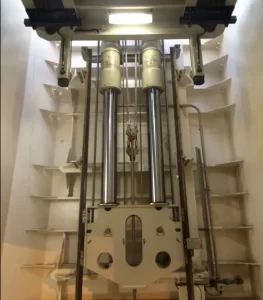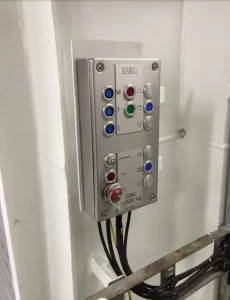The Safety Features of an Offshore Cargo Platform Lift

Read about the advantages of an offshore cargo lift
Given the inherent risks of rough seas and strong winds, offshore operations can be severely affected and sometimes dangerous. Hydraulic cargo platform lifts are indispensable in this harsh marine environment and integrating robust safety features is critical.
The safety features of cargo lifts help to reduce personnel accidents, prevent damage to valuable cargo, and enable a smooth operation. They help counter the unpredictable conditions when at sea and provide stability and security to every offshore lift operation. The following safety features help to ensure a safer offshore working environment, highlighting how cargo platform lifts have become essential to efficient and secure marine operations.
Closed Shaft
Hydraulic cargo lifts reduce the risk of damage during transit due to their closed lift shaft. This safety feature helps to protect both the platform lift mechanism and the cargo from external elements and possible mechanical failures. Closed lift shafts also remove the need for offshore personnel to stand near or beneath the cargo during transfer, enhancing crew safety by removing them from a potentially dangerous position.
Anti-Sway Technology
Maintaining stability is key during offshore operations. With rough seas and high winds accidents and instability are increased particularly when transporting cargo. Anti-sway technology mitigates the effects of the marine environment, actively stabilising the cargo lift platform, preventing unwanted swaying and ensuring smooth, controlled movement during the cargo transfer.
Pawl Device
Pawl devices stop cargo platform lifts from sinking when it is loaded and ensure lift stability and security throughout the operation. This particular safety feature is crucial for maintaining the integrity of offshore platform lifts when moving with heavy loads.
Overload Sensors
HML integrate sophisticated overload protection systems into their hydraulic cargo lifts. These assess weight distribution and load capacity, detecting if the weight exceeds what is safe. If so they will immediately halt the offshore lift’s operation and alert personnel to take corrective action. Overload sensors are essential to a successful and secure offshore operation as they help to prevent structural damage and help ensure the safety of both crew and cargo.
Check out what other offshore products HML offer

Emergency Stop
Offshore cargo lifts are all installed with emergency stop buttons strategically placed to cause an instantaneous halt to all operations. In case of an emergency, this ensures a quick response time to potential hazards. If there is a power failure or lift system malfunction, manual controls are an essential backup to automated systems that allow operators to safely manage the cargo platform lift.
Fail-Safe Mechanisms
Hydraulic cargo lifts are equipped with fail-safe mechanisms that will automatically activate if there is a malfunction. These ensure lift stability and that it remains operational during potentially dangerous circumstances. Multiple fail-safe devices are included to provide additional layers of protection so if one system were to fail, then the others would offset any other problems and maintain cargo platform lift safety.
Weather-Tight Seals
All HML lifts are custom-made and their offshore cargo lifts incorporate weather-tight seals and flush hatches that ensure that no matter the weather condition the lift remains operational preventing water entering and corrosion. The cargo lift platform can function as an integrated flush hatch as it will protect against the elements when the lift is not in use.
With all of Holland Marine Lifts’ projects, safety is at the forefront. We design our offshore cargo platform lifts with safety features that will address the unique challenges offshore operations face. Our hydraulic lifts ensure the highest levels of security and reliability. By including all of our essential cargo platform lift safety features we don’t only enhance the efficiency of cargo transfer but safeguard the well-being of offshore operators, crew, and the cargo itself.